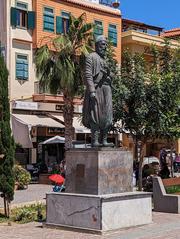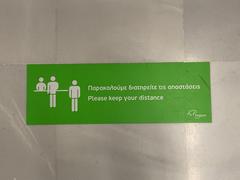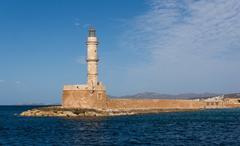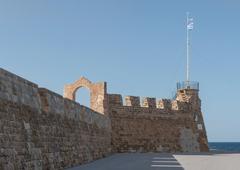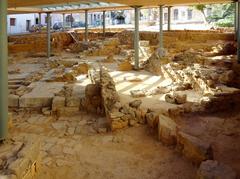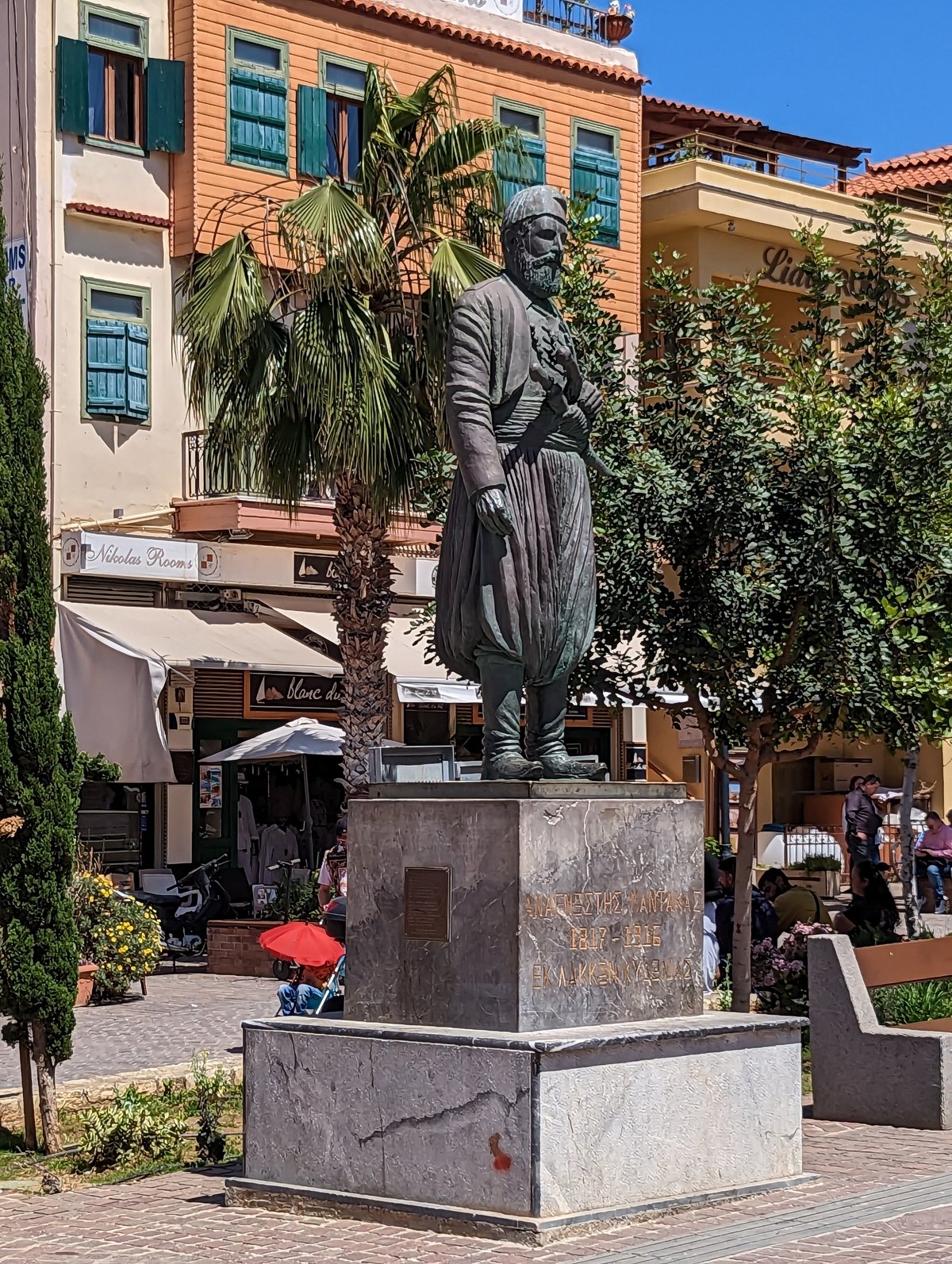
Statue of Anagnostis Mantakas in Chania, Greece: Visiting Hours, Tickets, and Comprehensive Guide
Date: 14/06/2025
Introduction
The Statue of Anagnostis Mantakas in Chania, Crete, stands as a powerful symbol of the island’s long struggle for freedom and identity. Situated in Plateia Mitropoleos (also known as Plateia Athinagora) within Chania’s historic Old Town, this monument honors Anagnostis Mantakas, a revered Cretan freedom fighter whose leadership contributed significantly to Crete’s autonomy and eventual union with Greece. This guide provides a detailed overview of the statue’s historical context, practical visitor information, nearby attractions, cultural significance, and travel tips, making it a valuable resource for history enthusiasts, cultural travelers, and casual visitors alike (Alamy; Greek Reporter; Corvinus; Chania Tourism).
Historical Background
Anagnostis Mantakas and the Cretan Struggle
Anagnostis Mantakas is celebrated as a key figure in Crete’s resistance against Ottoman rule in the 19th century. As a leader of the Cretan revolts, he embodied the island’s quest for autonomy, which was achieved in 1898, and later the union with Greece in 1913. Mantakas is remembered for his courage and leadership, particularly during the Cretan Revolt of 1866–1869, which drew international attention and highlighted the resilience of the Cretan people (Alamy; Corvinus).
The Ottoman Period and Resistance
Chania, under Ottoman control from 1645, witnessed cultural shifts and ongoing resistance due to religious and social oppression. The city became a focal point of rebellion, with figures like Mantakas leading efforts that ultimately paved the way for Crete’s liberation and union with Greece. The legacy of these struggles is central to the significance of the statue.
Artistic Description and Symbolism
The statue of Anagnostis Mantakas is a striking bronze monument depicting him in traditional Cretan attire—headscarf, boots, and chieftain’s garb—symbolizing local identity and resistance. His posture and expression convey determination and pride, while the base bears inscriptions honoring his contributions to Crete’s liberation. Its prominent location in a bustling square ensures that the memory of Mantakas remains present in the daily life of Chania (Getty Images).
Statue Location and Accessibility
- Address: Plateia Mitropoleos (Plateia Athinagora), Chania Old Town
- Accessibility: The statue is located in a flat, pedestrian-friendly square, suitable for visitors with mobility considerations. It can be easily reached on foot from major tourist areas and is close to public transportation options.
- Nearby Landmarks: Chania Cathedral, Venetian Harbor, Mosque of the Janissaries, local markets, and museums (Chania Tourism).
Visiting Hours and Tickets
- Hours: The statue is outdoors and accessible 24 hours a day, 7 days a week, year-round.
- Admission: There is no entrance fee or ticket required.
- Guided Tours: While there are no official guided tours dedicated solely to the statue, many walking tours of Chania’s historical sites include it as a highlight. Local tour operators and hotels can provide recommendations (Freetour Expert).
Best Times to Visit
- Optimal Seasons: Visit between April and June or September and October for pleasant weather and fewer crowds.
- Summer Months: July and August can be hot and busy; if visiting during this period, arrive early or late in the day for a more comfortable experience and better lighting for photography (HikersBay).
Facilities and Nearby Amenities
- Restrooms: Available at the Municipal Market and major nearby attractions.
- Cafés and Restaurants: Numerous options in Old Town offer traditional Cretan cuisine.
- Shops: Souvenir stores and boutiques are abundant.
- Seating: Benches and shaded spots are available in and around the square (Stay Wild Travels).
Accessibility for All Visitors
Chania’s Old Town features cobblestone streets and some uneven surfaces. However, the main squares and thoroughfares near the statue are generally accessible, with ramps increasingly installed for those with mobility needs. For specific concerns, contact the Chania Tourist Information Office (Arrival Guides).
Safety and Security
Chania is a safe city for travelers. The statue area is well-patrolled and busy. Exercise standard precautions: keep personal belongings secure and be mindful in crowded areas.
Photography and Etiquette
The statue offers excellent photo opportunities, especially in the early morning or late afternoon. Please avoid climbing or damaging the monument, particularly during commemorative events.
Cultural Significance and Annual Events
The statue is a focal point for local commemorations, especially those related to Cretan revolts and the union with Greece. Annual events may include wreath-laying ceremonies, traditional music, and dance performances, particularly on significant dates like December 1st (Union of Crete with Greece) (Travel.gr).
Nearby Historical Sites and Attractions
- Chania Cathedral (Trimartiri): A central religious and architectural landmark.
- Venetian Harbor: Picturesque waterfront with historical significance.
- Mosque of the Janissaries: The oldest Ottoman building in Crete.
- Firka Fortress: At the harbor entrance, offers panoramic views.
- Municipal Market (Agora): A hub for local products (check for current renovation status).
- Splantzia District: Known for authentic local culture and historic churches.
- Archaeological Museum of Chania: Showcasing artifacts from Minoan to Roman times (Archaeological Museum of Chania).
- Maritime Museum of Crete: Illustrating the island’s naval history (Maritime Museum of Crete).
- Kucuk Hasan (Janissaries) Mosque: Waterfront venue for exhibitions (Chania Tourism).
- Kastelli Hill: Ancient Kydonia site with city views (Travel.gr).
- Minoan’s World 3D Museum: Interactive history and mythology (Minoan’s World).
- Venizelos Graves: Resting place of Eleftherios Venizelos, with panoramic vistas (Discover Greece).
Practical Visitor Tips
- Wear comfortable shoes for walking on cobblestone streets.
- Bring water and sunscreen, especially in summer.
- Start early to avoid heat and crowds.
- Purchase travel insurance for peace of mind (The Tiny Book).
- Parking: Limited in Old Town; use public lots on the outskirts and consider the iPark Chania app for parking payments.
- Language: Greek is official, but English is widely spoken.
- Cultural sensitivity: Respect local customs and commemorative events (Greeka).
Accommodation Options Nearby
- 11City Rooms: Budget, central.
- Porto Veneziano: Mid-range, waterfront.
- Alcanea Boutique Hotel: Luxury, historic charm (The Tiny Book).
Emergency Contacts
- Police: 100
- Ambulance: 166
- Fire Department: 199
- European Emergency Number: 112
Frequently Asked Questions (FAQ)
Q: What are the visiting hours and admission fees?
A: The statue is accessible 24/7, free of charge.
Q: How do I get there from Chania International Airport?
A: Taxi, public bus, or rental car to city center; the statue is within walking distance.
Q: Are guided tours available?
A: Yes, many local walking tours include the statue.
Q: Is the area accessible for visitors with mobility issues?
A: Main squares are accessible; for specific concerns, contact the tourist office.
Q: Where can I park?
A: Use public lots on the outskirts and the iPark Chania app for convenience.
Conclusion
Visiting the Statue of Anagnostis Mantakas provides a meaningful connection to Crete’s history, identity, and traditions. Its central location, free access, and proximity to Chania’s key historical sites make it an essential stop for any visitor. To enrich your experience, explore the surrounding Old Town, participate in local events, and consider a guided tour for deeper historical context.
Plan Your Visit
- Location: Plateia Mitropoleos (Plateia Athinagora), Chania Old Town, Crete
- Accessibility: Pedestrian-friendly and open all day
- Best Time to Visit: April–June or September–October
- Nearby Attractions: Chania Cathedral, Venetian Harbor, Mosque of the Janissaries, local markets and museums
For more immersive experiences, download the Audiala app for guided tours and real-time updates, and visit the Chania Tourism website for the latest information.
